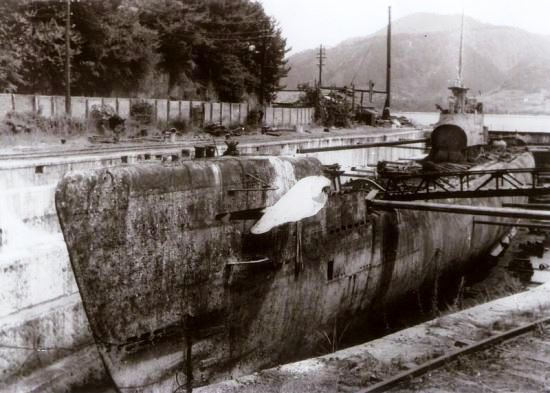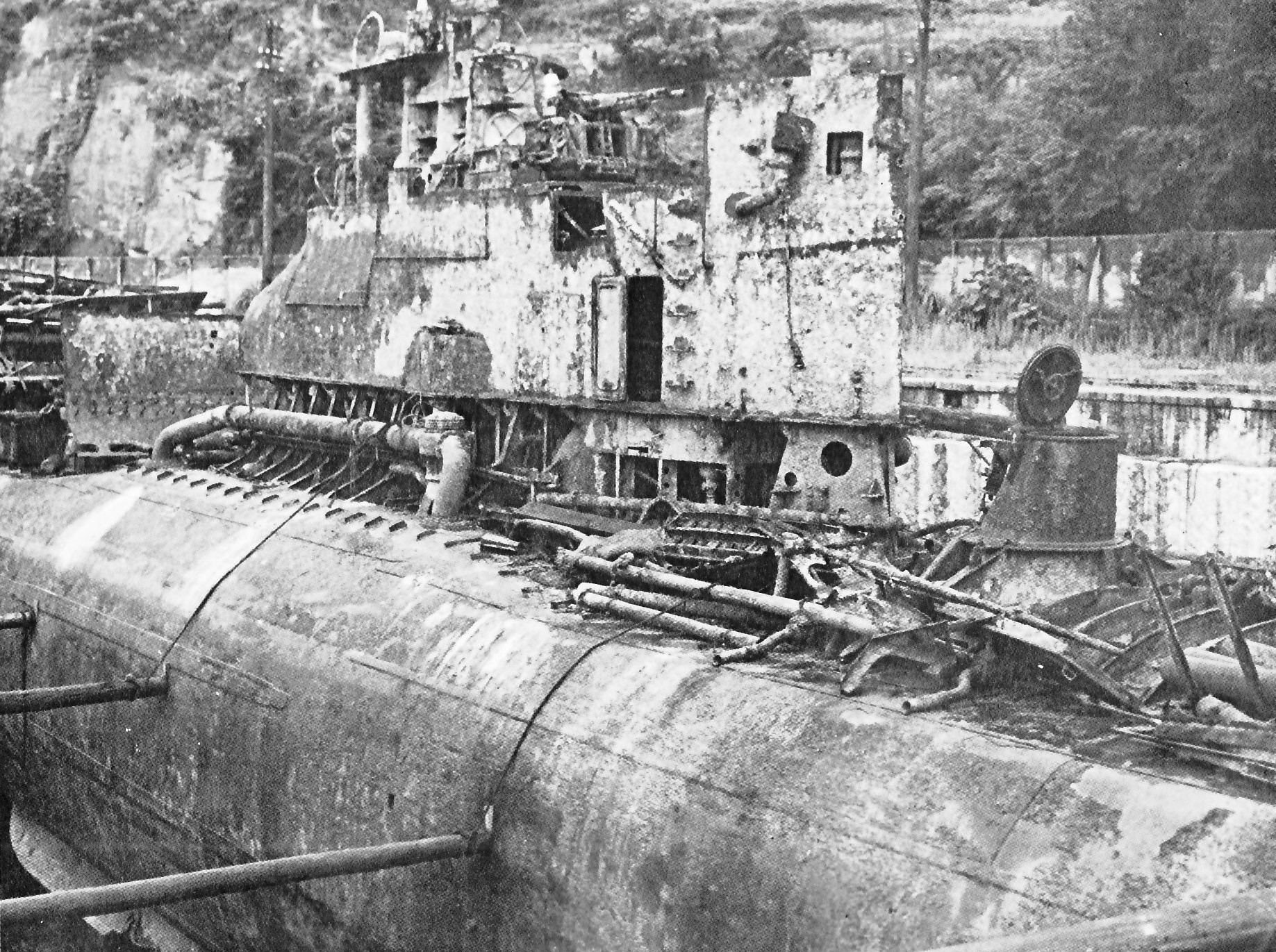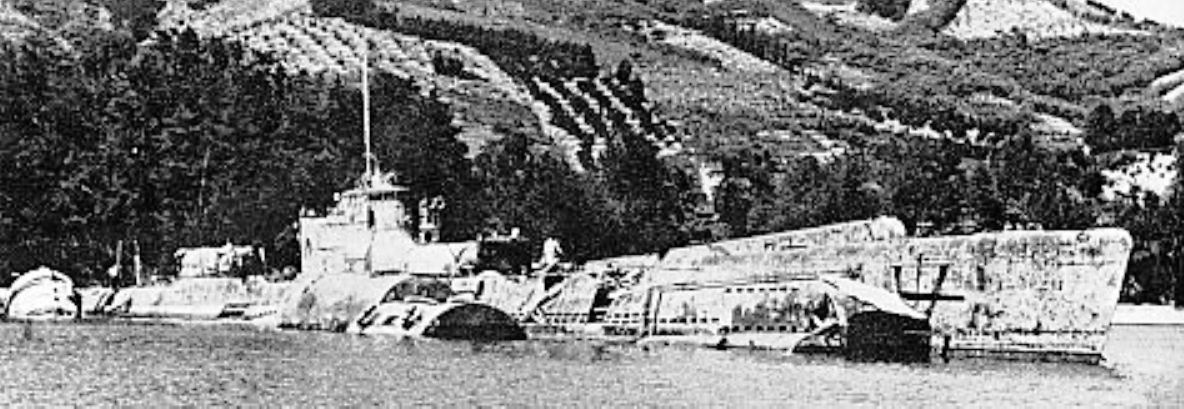21 February 1940:
Kobe. Laid down at Mitsubishi Shipbuilding's
Yard as Submarine No. 146.
25 March 1941:
Renumbered I-41.
1 May 1941:
Launched as I-41.
1 November 1941:
Renumbered I-33.
20 March 1942:
Cdr (later Captain) Shichiji Tsuneo (49)(current Chief
Equipping Officer of I-11) is appointed CEO of I-33 as an additional duty.
20 April 1942:
Cdr (Captain, posthumously) Ogawa Tsunayoshi (50)
(former CO of I-64) is appointed CEO of I-33 and I-35 (until 23 May) as an additional duty.
10 June 1942:
I-33 is completed, registered in the Kure Naval District
and attached to SubDiv 15 of Rear Admiral Yamazaki Shigeaki's SubRon 1 with 1-31
and I-32. Cdr Ogawa is the Commanding Officer.
7 August 1942 - 9 February 1943: American Operation "Watchtower" - The
Invasion of Guadalcanal, British Solomon Islands:
Rear Admiral (later
Admiral) Richmond K. Turner's Amphibious Task Force 62, covered by Vice Admiral
(later Admiral) Frank J. Fletcher's Task Force 61 and Rear Admiral (later
Admiral) John S. McCain's Task Force 63's land-based aircraft, lands Maj Gen
(later Gen/Commandant) Alexander A. Vandegrift's 1st Marine Division on
Guadalcanal opening a seven-month campaign to take the island.
15 August 1942:
Departs Kure via Truk for the Solomons area. Takes up
position in a picket line S of San Cristobal Island.
24 August 1942: The Battle of the Eastern Solomons:
Vice Admiral
(later Admiral) Frank J. Fletcher's Task Force 61's USS SARATOGA (CV-3) and
ENTERPRISE (CV-6) launch aircraft that find and sink light carrier RYUJO. In
turn, CarDiv 1's SHOKAKU and ZUIKAKU launch aircraft that find and damage
ENTERPRISE. That evening, aircraft from SARATOGA damage seaplane carrier
CHITOSE.
At 1105, the SBD-3 piloted by Lt. Roger B. Woodhull of VF-5 from USS
ENTERPRISE, flying intermediate air patrol, sights and attacks the surfaced I-33,
proceeding to a new position, at 09-21S, 163-35E. The submarine crash-dives
immediately without receiving any damage.
30 August 1942:
I-33 sights an enemy task force, but fails to gain an
attack position.
20 September 1942:
I-33 departs her patrol area for Truk.
25 September 1942:
Arrives at Truk. Half of her crew is granted
liberty.
26 September 1942:
Truk. I-33 is moored alongside of Sixth Fleet
repair ship URAKAMI MARU while her stern is secured to the wharf on Natsushima
(Dublon) Island. Early in the morning the remaining crew and three engineers
from URAKAMI MARU start repairs of I-33's lowermost port torpedo tube No. 6.
At 0921, in a misguided attempt to minimize the influence of swells and
to raise I-33's bow, her navigator, as senior officer aboard, permits the drain
cock of the aft main tanks to be opened. The buoyancy of the partially flooded
submarine is seriously compromised. The hawsers securing the stern snap, the
forward torpedo hatch floods and I-33 sinks in just two minutes! Thirty-three
crewmen are lost.
Cdr Ogawa and ComSubDiv 15 (both aboard URAKAMI MARU) immediately
launch a rescue operation. A diver locates the submarine on the sea bottom in
120 feet of water and reports that some crewmembers are still alive.
Due to the lack of equipment and divers, the rescue attempt ends in total
failure.
27 September 1942:
The Sixth Fleet abandons attempts to rescue the
trapped crew. Rear Admiral Ugaki Matome (former CO of HYUGA), Chief of Staff of
the Combined Fleet, appoints Rear Admiral Takayanagi Gihachi, CO of battleship
YAMATO, anchored at Truk, to head an investigating committee.
30 September 1942:
The Navy Ministry orders I-33 salvaged, but proper
equipment is not available at Truk.
2 October 1942:
The Combined Fleet tasks Vice Admiral Inoue Shigeyoshi
(former CO of HIEI), CINC, Fourth Fleet to salvage I-33.
19 December 1942:
The hull of sunken I-33 is pressurized and her
bow breaks the surface, but three minutes later the overpressure bursts a hatch
and she again sinks.
25 December 1942:
Converted rescue vessel MIE MARU and tanker NIPPO
MARU commence a new salvage operation.
29 December 1942:
I-33 is finally raised and refloated successfully.
2 March 1943:
Departs Truk for Kure under tow by NIPPO MARU. En route
auxiliary gunboats CHOUN MARU and HEIJO MARU join the small convoy, followed by
destroyer YUNAGI on 9 March.
17 March 1943:
The NIPPO MARU convoy arrives at Saeki where it is
dissolved.
18 March 1943:
I-33 arrives at Kure. Undergoes repairs at the Kure
Navy Yard.
1 April 1944:
Assigned to the Kure Guard Unit. Work continues until
early May. I-33 is fitted with a Type 22 radar and radar detector.
1 May 1944:
Cdr (later Captain) Ikezawa Masayuki (52)(staff officer of
submarine department at Kure Navy Yard) is appointed CO of I-33 as an additional
duty.
14 May 1944:
LtCdr (Cdr, posthumously) Wada Mutsuo (61)(former CO of
RO-42) is appointed CO.
1 June 1944:
End of repairs. Reassigned to SubRon 11, Sixth Fleet.
13 June 1944:
At 0700, I-33 departs Kure for a series of dives in the
Iyo Nada to complete her acceptance trials. At 0840, LtCdr Wada orders a crash
dive for the second time, but the starboard main induction valve fails to close,
flooding all sections abaft the control room. The crew succeeds in blowing main
ballast tanks partially. Ten minutes after the accident, I-33's bow breaks the
surface for a few seconds. Nevertheless, the flooding continues and the
submarine settles to the bottom in 180 feet of water.
Ten officers and ratings including LtCdr Wada are isolated in the control
room; thirteen sailors are trapped in the forward crew compartment. As the
flooding increases, Wada orders everyone to leave the boat through the conning
tower. He elects to remain aboard himself.
Eight sailors from the control room reach the surface, but they soon
drift apart. One group attempts to reach Yurishima in the north, the other heads
for Aoshima Island, SW of the site of the accident. Exhausted, most of them
perish. Only Ensign Konishi Yoshiaki (72), the Communications/Gunnery Officer,
and PO1c Okada Kenichi reach Yurishima.
The sailors trapped in forward crew compartment attempt to surface
through the escape trunk but its lower hatch is jammed. They soon perish of
asphyxiation. The last survivor commits suicide. A total of 102 crewmembers are
lost.
A few hours later, Konishi and Okada are discovered by local fishermen
and taken to the nearby Mitohama town. The survivors contact the headquarters of
the Matsuyama Naval Air Group. The Matsuyama NAG then informs the Kure naval
base. Later, submarine tender CHOGEI picks up both sailors at Nagahama Bight
and heads for Iyo Nada.
14 June 1944:
Early in the morning, search aircraft discover the area
covered with diesel oil and guide CHOGEI to that point.
15 June 1944:
Divers from CHOGEI locate the wreck. The corpses of two
sailors found entangled in the bridge enclosure are brought to the surface. The
divers also find a piece of wooden scaffolding, two inches in diameter, that
had slipped into the air-induction line during the repairs at Kure and jammed
the valve during the final dive.
16 June 1944:
A crane-equipped salvage barge arrives from Kure. In the
evening all rescue efforts are terminated because of a typhoon.
No enquiry to explore the causes of the loss takes place because all
officers involved in the investigation are soon transferred to Saipan. Most of
them are KIA subsequently.
10 August 1944:
Removed from the Navy List.
June 1953:
The Hokusei Sempaku salvage firm begins to salvage I-33.
23 July-18 August 1953:
The wreck of I-33 is raised. The salvagers find that the forward compartments are not flooded. I-33 is later scrapped at Hitachi's Innoshima Yard.







